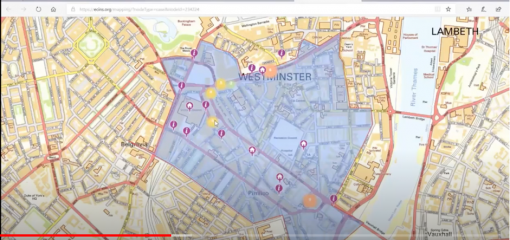Interview with Claire Hardy, Community Safety Manager, Westminster City Council
We were pleased to be joined by Claire Hardy, Community Safety Manager from Westminster City Council for a recent virtual meeting where she took us through the ways the Borough are using ECINS to manage their Community Protection Notice Zones. Claire gave us some fantastic examples of some of the ways they use the ECINS mapping functionality and how this can be applied to a number of areas of business especially for intelligence gathering, exclusion zones and for multi-agency problem solving approaches.
Watch an extract from the interview with Claire in this video clip
Gary Pettengell: How do you use ECINS to manage Street ASB and enforcement in Westminster?
Claire Hardy: There is a lot going on at the moment in the world of street ASB and enforcement; we are formalising our first Street based ASB strategy and Westminster is in the process of lobbying government for future consideration of purpose fit legislation to address such complex issues. The current approach we use for Street ASB and enforcement is Community Protection Notices, although we are investigating the appetite for a Public Spaces Protection Order. We have created CPN zones across the borough, evidenced through the generic victim impact in those zones and have created written warning / Community Protection Notice sets, addressing those behaviours complained about.
We use the mapping functionality to visualise CPN Zones on ECINS. To do this, we create a polygon of the zone within the case, spanning the area justified by the victim impact; and use Reports to document each warning or Notice served.
Reports are ideal, as within the report you have the geo tag of where the offence was, date and time of the offence, statement of service, the photo of the offence and the scanned copy of the written warning or CPN uploaded, enabling officers to access the evidence of the offence for future case building without chasing. The report is attached to the CPN case as well as the offender profile.
This enables us to map from a location-based issue any of the hotspots within that zone and where we might need to do further work from a problem-solving perspective. We can also track our individuals who are coming to notice by seeing how many written warnings or CPNs they have actually got in their profile.
Reports are incredibly vital to us because when we download the data from ECINS it gives us coordinates so that we can get heatmaps across the whole city and that sits very nicely with our analysts. This is something we are developing more and more.

Gary Pettengell: how do you use ECINS Reports with the mapping functionality to help to identify problem areas?
Claire Hardy: On the Case we have all of the Reports and the offender’s profiles too. When it is opened up on a map you can quickly see the benefit of using the report. The blue polygon shows the area we know we are justified to use that tool because that is where all of the victim impact has been collated.
From a location base what our Neighbourhood Coordinators would do is look at this and understand exactly what the behaviours are of the street population on the ground in that area or hotspot. For example, we can quickly see that Pimlico Underground area is a hotspot where we need to do more focused joint operations work with TFL and the Underground management team. We can see the same at McDonalds and Pret-a-manger where there is a covered alcove where people sit on chairs and tables and has become a hotspot. One of the exits of Victoria Station underneath the archway has a lot of dead land where people are setting up encampments or using it as a congregation point to sort out their begging money. That is how we can literally see the picture on the ground.
All our officers need to do when serving the written warning or the CPN on the ground is enter a report and upload their documents. They do not need to know anything else about ECINS other than that one simple process. It is not onerous at all and this is where we store all of our ASB Tools and Powers and Outputs.
Gary Pettengell: How do you manage rough sleeping in Westminster?
From an ASB perspective, we have an Integrated Street Engagement Unit which is a multi-agency team comprising of City Inspectors who help with enforcement, coordinating cleansing and clearing of hotspots, a dedicated ASB case worker and Police. We are currently reviewing the team with a view to further integrate services enabling a holistic approach to case management and hotspots alongside our commissioned outreach services. The tri-borough ISEU Police team that supports us addresses the immediate issues – addressing criminality and ASB as soon as it happens. The longer process of complex case management of street population is channelled in to case conferences with our dedicated Street Population case worker.
Westminster is unique in that we normally evidence higher levels than surrounding boroughs of the more traditional rough sleepers. We also have to consider the large numbers of foreign nationals who either rough sleep in the borough, commute in or actually do live in accommodation. This cohort are attracted to the City for the large sums of money that can be made through pick pocketing, theft, begging, flower selling etc and we are investigating the organised crime links that may be enabling their presence. Many of these nominals live outside of the Borough and come in from surrounding boroughs, so in the past we have linked in with these areas so they can address and take Tenancy Enforcement Action while we are dealing with the actual offences within our Borough.
We have shown the Home Office how we map data out against the individual as well as the Borough showing how it is possible see the transient link and the linking across to other Boroughs who are also using ECINS. We currently have many high-risk high-harm people being independently case managed for various different offences as well as the team tackling the high volume low level crime in terms of begging etc, both having significant impact on our communities. These are two separate cohorts with two different methods and both are being managed on ECINS.
Paul Dunn: You can see the history of the individual at a glance but more importantly where they are having an impact on the Borough – different CPNs, CPNWs. The emerging issues must be really useful in this approach identifying hotspots, identifying the right resources in the right places at the right time to deal with these sorts of issues. Can you see this work with other areas of business?
Claire Hardy: Absolutely! This type of mapping of an individual would be phenomenal for issues such as Gang involvement within County Lines. I really do think people are missing a trick if they are not using the geo tag and mapping function. Can you imagine if the agencies involved in County Lines could put a pin point into a location where they found an victim, attach an intel report, locked down for data and details, then cross reference with the same approach for intelligence mapping of known gang nominals……? You would be able to actually visualise the potential whereabouts and patterns of behaviours to start drilling down who may be responsible for this horrendous criminal activity. That is definitely one of the biggest plus sides to the ECINS software platform. I have never seen this before in terms of functionality in any other platforms.
Sarah Pettengell: I have never heard of such a creative way of maximising ECINS Reports and many schemes don’t even use Reports. Some schemes just use Cases, Profiles, Logs and Actions. What you have described in this process has prompted me to reinvent the uses of Reports that really unlocks the use of mapping. How would you suggest best practice?
Claire Hardy: Reports can be free floating but you can use them for two purposes to maximise the visualisation.
1) Attached to a profile to start understanding the levels of intelligence and offences of an individual in one place.
2) Tracking ability of the individual, if all the reports are attached to an intel case for the offender.
This is particularly useful if you want to start identifying patterns and locations of behaviour. For example: if the offender’s behaviour is always occurring in the south of the borough, except for a few times it shows up in the north, you can start asking the question why? Is it a regular weekly occurrence? Are they actually delivering drugs to the north once a week, when they normally just operate in the south?
Food for thought, and just imagine if you could do that across the UK?
Paul Dunn: That is really useful for exclusions, identifying places you need to take into consideration, not just the CPN areas. Could it help you visualise whether you are going to displace individuals to specific areas where it could become equally problematic and give you the evidence to ensure that it doesn’t happen with displacement?
Claire Hardy: That is the beauty of ECINS Reports. Say for example you are going for a Criminal Behaviour Order – all of that intel and ASB impact is contained within each Report so all you would need to do is open a CBO case, link it to any of the Reports that are relevant from your instant logs and then you automatically have your Exclusion Zone mapped out for you to print screen. You only have to show that picture to the Magistrate for them to see exactly what the problem is.
Paul Dunn: One of the things we are really looking at is improving people’s knowledge of the ECINS mapping functionality. You can map on people, the type of offences they are involved in whether they are high, medium or low priority and you can put a map on top of another map and prove these individuals are the ones causing a problem in a particular area and put an action plan together about how you are going to tackle it. Could you see a benefit in using it across wider geographic locations?
Claire Hardy: If you are going to translate it from Rough Sleepers to Gangs there is so much scope especially if it can work with other boroughs who are using it and embracing it fully. If we can standardise that across all of the ECINS users it will become so much clearer and so much easier. We still have to do so much background work to try to find out why someone has just presented in an area causing problems when they should be in Glasgow for example. We will only uncover information once we have spoken with Probation and then we have spoken with someone else and done a deep dive to find out connections. If each borough was putting information on ECINS in the same way it would really help us to connect with those officers and get the whole picture across the UK.
Paul Dunn: I know we are speaking about rough sleepers but this is also invaluable for problem solving groups. It could be adopted into all sorts of areas of business extending and enhancing the intelligence information you can record about the tracking of individuals.


